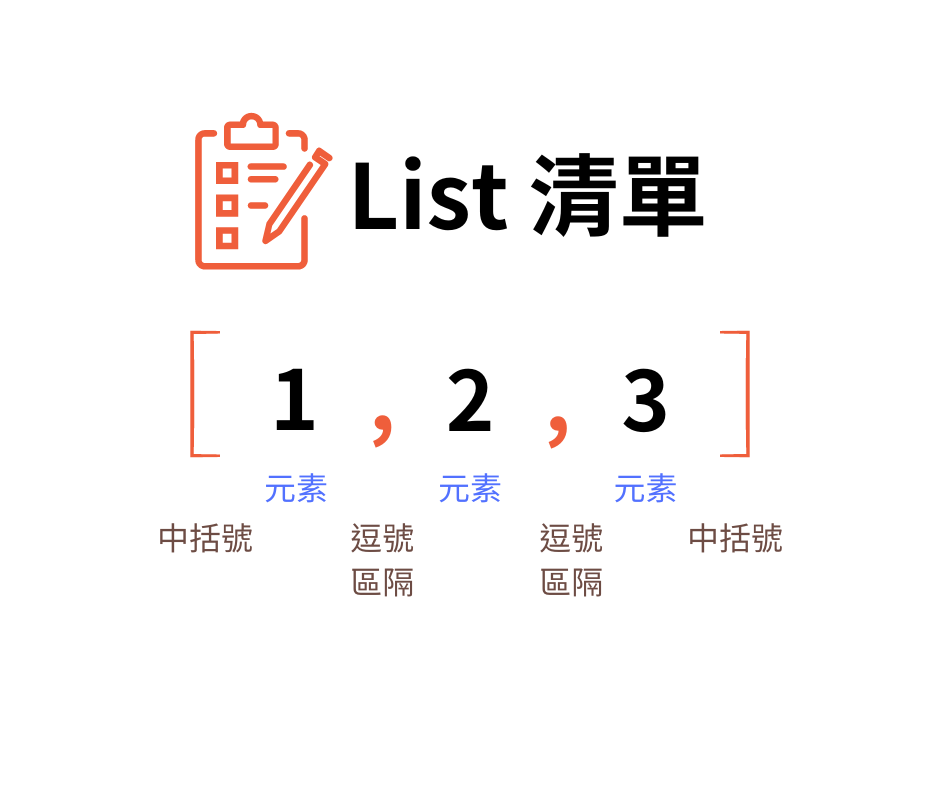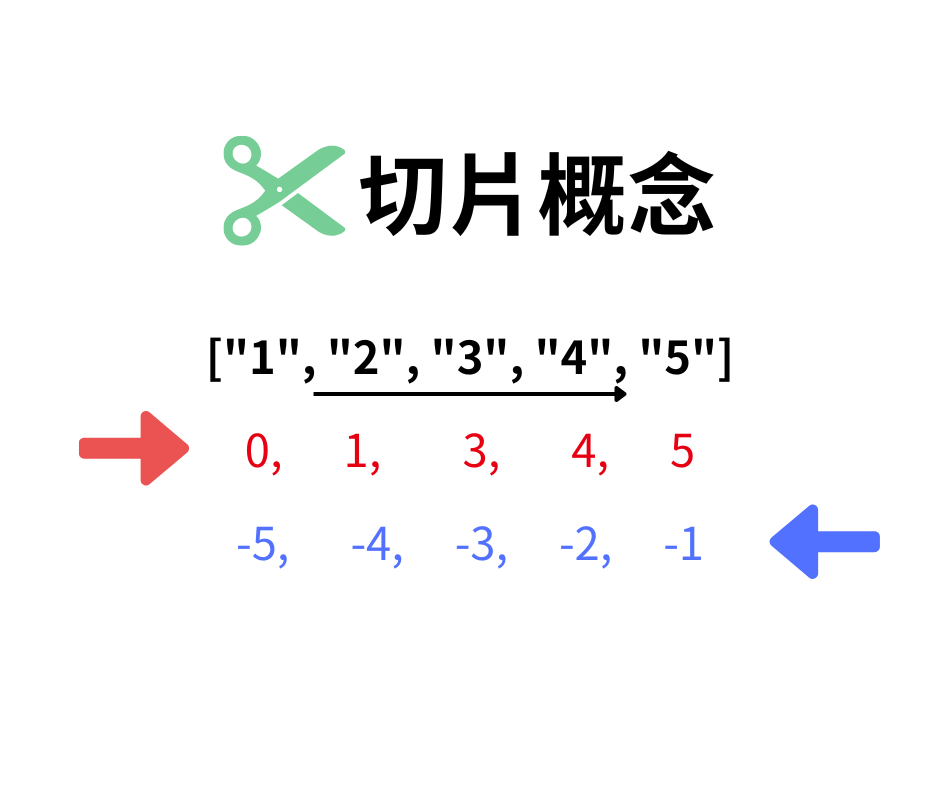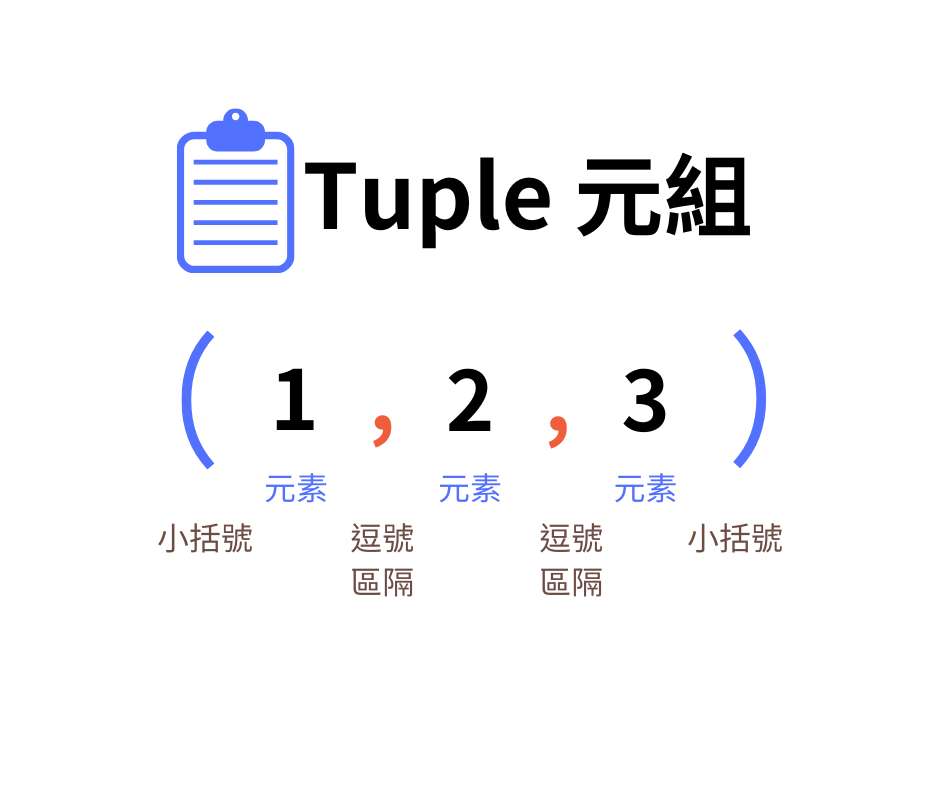清單在Python裡面非常的常用,大家一定要熟練這些基礎的元素。

在Python中,列表(List)是一種常用的資料類型,用於儲存一組有序的元素。列表是可變的(Mutable),這意味著你可以在列表中新增、刪除和修改元素。列表使用方括號 [] 來表示,元素之間用逗號 , 分隔。以下是列表常用的操作:
fruits = ['apple', 'banana', 'orange', 'grape']
numbers = [1, 2, 3, 4, 5]
mixed_list = [1, 'apple', True, 3.14]
fruits = ['apple', 'banana', 'orange', 'grape']
print(fruits[0]) # 輸出:'apple'
print(fruits[2]) # 輸出:'orange'
fruits = ['apple', 'banana', 'orange', 'grape']
fruits[1] = 'pear'
print(fruits) # 輸出:['apple', 'pear', 'orange', 'grape']
fruits = ['apple', 'banana', 'orange', 'grape']
fruits.append('watermelon')
print(fruits) # 輸出:['apple', 'banana', 'orange', 'grape', 'watermelon']
fruits = ['apple', 'banana', 'orange', 'grape']
del fruits[1]
print(fruits) # 輸出:['apple', 'orange', 'grape']

fruits = ['apple', 'banana', 'orange', 'grape']
slice_fruits = fruits[1:3]
print(slice_fruits) # 輸出:['banana', 'orange']
fruits = ['apple', 'banana', 'orange', 'grape']
length = len(fruits)
print(length) # 輸出:4
fruits = ['apple', 'banana', 'orange', 'grape']
print('banana' in fruits) # 輸出:True
print('watermelon' not in fruits) # 輸出:True
| 方法 | 描述 | 範例 fruits = ['apple', 'banana']; |
|---|---|---|
| append() | 在列表末尾添加元素 | fruits.append('orange') → ['apple', 'banana', 'orange'] |
| extend() | 將可迭代的元素添加到列表末尾 | fruits.extend(['orange', 'grape']) → ['apple', 'banana', 'orange', 'grape'] |
| insert() | 在指定位置插入元素 | fruits.insert(1, 'orange') → ['apple', 'orange', 'banana'] |
| remove() | 移除第一次出現的指定元素 | fruits.remove('banana') → ['apple'] |
| pop() | 移除指定位置的元素(預設為最後一個元素),並返回該元素 | removed_fruit = fruits.pop(1) → removed_fruit = 'banana'; fruits = ['apple'] |
| clear() | 清空列表中的所有元素 | fruits.clear() → [] |
| index() | 返回第一次出現指定元素的索引,如果不存在則引發 ValueError | index = fruits.index('banana') → index = 1 |
| count() | 返回指定元素在列表中出現的次數 | count = fruits.count('banana') → count = 2 |
| sort() | 對列表進行排序(預設遞增排序),原地排序 | fruits.sort() → ['apple', 'banana'] |
| reverse() | 將列表中的元素反向排序,原地操作 | fruits.reverse() → ['banana', 'apple'] |
| copy() | 複製列表 | new_fruits = fruits.copy() → new_fruits = ['apple', 'banana'] |
列表是一種非常有用的資料類型,它可以用來儲存各種不同類型的元素。你可以使用這些操作來創建、修改、添加、刪除和查詢列表中的元素。

在Python中,元組(Tuple)是另一種常用的資料類型,用於儲存一組有序的元素。不同於列表,元組是不可變的(Immutable),這意味著一旦創建了元組,就無法修改其內容。元組使用圓括號 () 來表示,元素之間用逗號 , 分隔。以下是元組常用的操作:
fruits_tuple = ('apple', 'banana', 'orange', 'grape')
numbers_tuple = (1, 2, 3, 4, 5)
mixed_tuple = (1, 'apple', True, 3.14)
fruits_tuple = ('apple', 'banana', 'orange', 'grape')
print(fruits_tuple[0]) # 輸出:'apple'
print(fruits_tuple[2]) # 輸出:'orange'
fruits_tuple = ('apple', 'banana', 'orange', 'grape')
# 以下操作會引發 TypeError: 'tuple' object does not support item assignment
fruits_tuple[1] = 'pear'
del fruits_tuple[2]
fruits_tuple = ('apple', 'banana', 'orange', 'grape')
fruit1, fruit2, fruit3, fruit4 = fruits_tuple
print(fruit1) # 輸出:'apple'
print(fruit2) # 輸出:'banana'
fruits_tuple = ('apple', 'banana', 'orange', 'grape')
length = len(fruits_tuple)
print(length) # 輸出:4
fruits_tuple = ('apple', 'banana', 'orange', 'grape')
print('banana' in fruits_tuple) # 輸出:True
print('watermelon' not in fruits_tuple) # 輸出:True
| 方法 | 描述 | 範例 |
|---|---|---|
| count() | 返回指定元素在元組中出現的次數 | fruits = ('apple', 'banana', 'banana', 'orange'); count = fruits.count('banana') → count = 2 |
| index() | 返回第一次出現指定元素的索引,如果不存在則引發 ValueError | fruits = ('apple', 'banana', 'orange'); index = fruits.index('banana') → index = 1 |
| len() | 獲取元組的長度 | fruits = ('apple', 'banana', 'orange'); length = len(fruits) → length = 3 |
| sorted() | 返回排序後的元組(由於元組是不可變的,這實際上創建了一個新元組) | fruits = ('orange', 'banana', 'apple'); sorted_fruits = sorted(fruits) → sorted_fruits = ('apple', 'banana', 'orange') |
| reversed() | 返回反向的元組(同樣是創建了一個新元組) | fruits = ('apple', 'banana', 'orange'); reversed_fruits = tuple(reversed(fruits)) → reversed_fruits = ('orange', 'banana', 'apple') |
| tuple() | 將可迭代的元素轉換為元組 | fruits_list = ['apple', 'banana', 'orange']; fruits_tuple = tuple(fruits_list) → fruits_tuple = ('apple', 'banana', 'orange') |
元組的不可變性使其在某些情況下比列表更適合使用,特別是在希望保證資料的不可變性時。你可以使用這些操作來創建、查詢元組中的元素以及進行元組解包。
列表(List)和元組(Tuple)是Python中兩種常用的資料結構,它們都用於儲存一組有序的元素。然而,它們之間有幾個主要的不同點:
[] 來創建,元素之間用逗號 , 分隔。() 來創建,元素之間用逗號 , 分隔。分享所學貢獻社會
[Python教學]開發工具介紹
[開發工具] Google Colab 介紹
[Python教學] 資料型態
[Python教學] if判斷式
[Python教學] List 清單 和 Tuple元組
[Python教學] for 和 while 迴圈
[Python教學] Dictionary 字典 和 Set 集合
[Python教學] Function函示
[Python教學] Class 類別
最後最後有一件小小的請求,請大家幫我填寫一下問卷,
讓我們知道你想上怎麼樣課程,感激不盡。
問卷這邊
Facebook 粉絲頁 - TechMasters 工程師養成記
